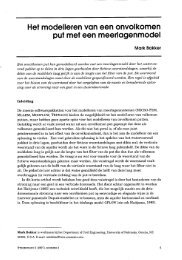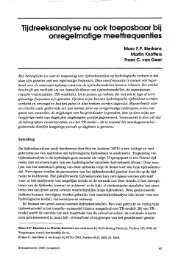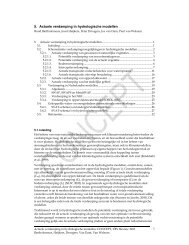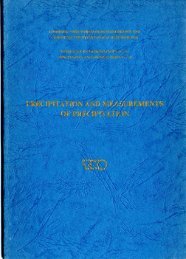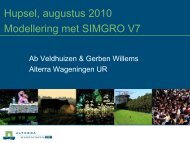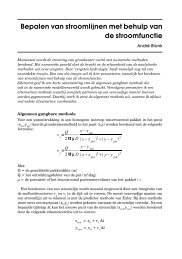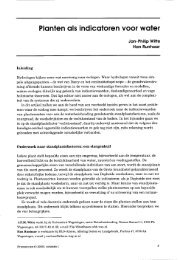Hydro-ecological relations in the Delta Waters
Hydro-ecological relations in the Delta Waters
Hydro-ecological relations in the Delta Waters
Create successful ePaper yourself
Turn your PDF publications into a flip-book with our unique Google optimized e-Paper software.
that chwged farnor reed mrshes and tidal flats fnto wet grasslands,<br />
<strong>the</strong> numbers of <strong>the</strong>se w<strong>in</strong>ter<strong>in</strong>g geese conld stabilize and even rise.<br />
In <strong>the</strong> new areas also important botanical values arid. The most<br />
strik<strong>in</strong>g example Is <strong>the</strong> developcent of: a wet dune-slack vegetation with<br />
rEre species like Parnassia pa<strong>in</strong>stris, Blackstonia gerfoliata and<br />
several species of orchids. This type of habitaf orig<strong>in</strong>ally occurred <strong>in</strong><br />
<strong>the</strong> lower parts of <strong>the</strong> coastal aunes. There it dieap~eated, however,<br />
almost totally because of <strong>the</strong> lower<strong>in</strong>g of <strong>the</strong> greundwator level.<br />
Especially on sandy soils with a stehle groundwater regime <strong>in</strong> <strong>the</strong> Lakes<br />
Be- and Grevel<strong>in</strong>gen hundreds of hectares of this particular<br />
vegetatipn type could develop and <strong>in</strong> <strong>the</strong> future probably also <strong>in</strong> <strong>the</strong><br />
Krammer-VolLerak.<br />
However, <strong>the</strong> new ereas are still <strong>in</strong> a dmamic state and <strong>the</strong> above-<br />
mestioned values mag be temposaq. The decllne of shote birds <strong>in</strong> <strong>the</strong><br />
Grevel<strong>in</strong>gen (Fig. 5) is a good exgmple M thSs. We also see that shrubs<br />
and trees beg<strong>in</strong> to caJoniee <strong>the</strong> dune-slack habitats and displace <strong>the</strong><br />
characteristic herbs. In a late* phase parts of <strong>the</strong> actual duna-slack<br />
enviro~nt will probably change because of decalcif4catiofi. In certa<strong>in</strong><br />
cases it is possible to stop or slow down natural succession by grazfng<br />
or mow<strong>in</strong>g, thua conserv<strong>in</strong>g certa<strong>in</strong> development stages by appropriate<br />
management methadv. However, we hme to realize that it ia not possible<br />
to keep <strong>the</strong> former estuar<strong>in</strong>e landscape <strong>in</strong> a young stage, because <strong>the</strong>re<br />
are ne cyclic dynamic processes to renew abiotic envimnment. In <strong>the</strong><br />
long run <strong>the</strong> ecosystems will grow to a more mature stage and this will<br />
<strong>in</strong>evitably lead to a decl<strong>in</strong>e of certa<strong>in</strong> species and <strong>the</strong> appearawe of<br />
o<strong>the</strong>rs, AL <strong>the</strong> moment it will be possible to keep certa<strong>in</strong> species by<br />
graz<strong>in</strong>g or mow<strong>in</strong>g Eor a certa<strong>in</strong> <strong>the</strong>. However, <strong>in</strong> <strong>the</strong> longer run <strong>the</strong>g<br />
will bisappeaz.<br />
Anyhow. it is qnite eLear that a graz<strong>in</strong>g management will lead te<br />
ecasystems totally different from those of spontaneous development or a<br />
w<strong>in</strong>g regime. And from that po<strong>in</strong>t of view <strong>the</strong> decision lies with <strong>the</strong><br />
etologists and <strong>the</strong> nature management: what type of nature do we wane on<br />
<strong>the</strong> new emerged land?





